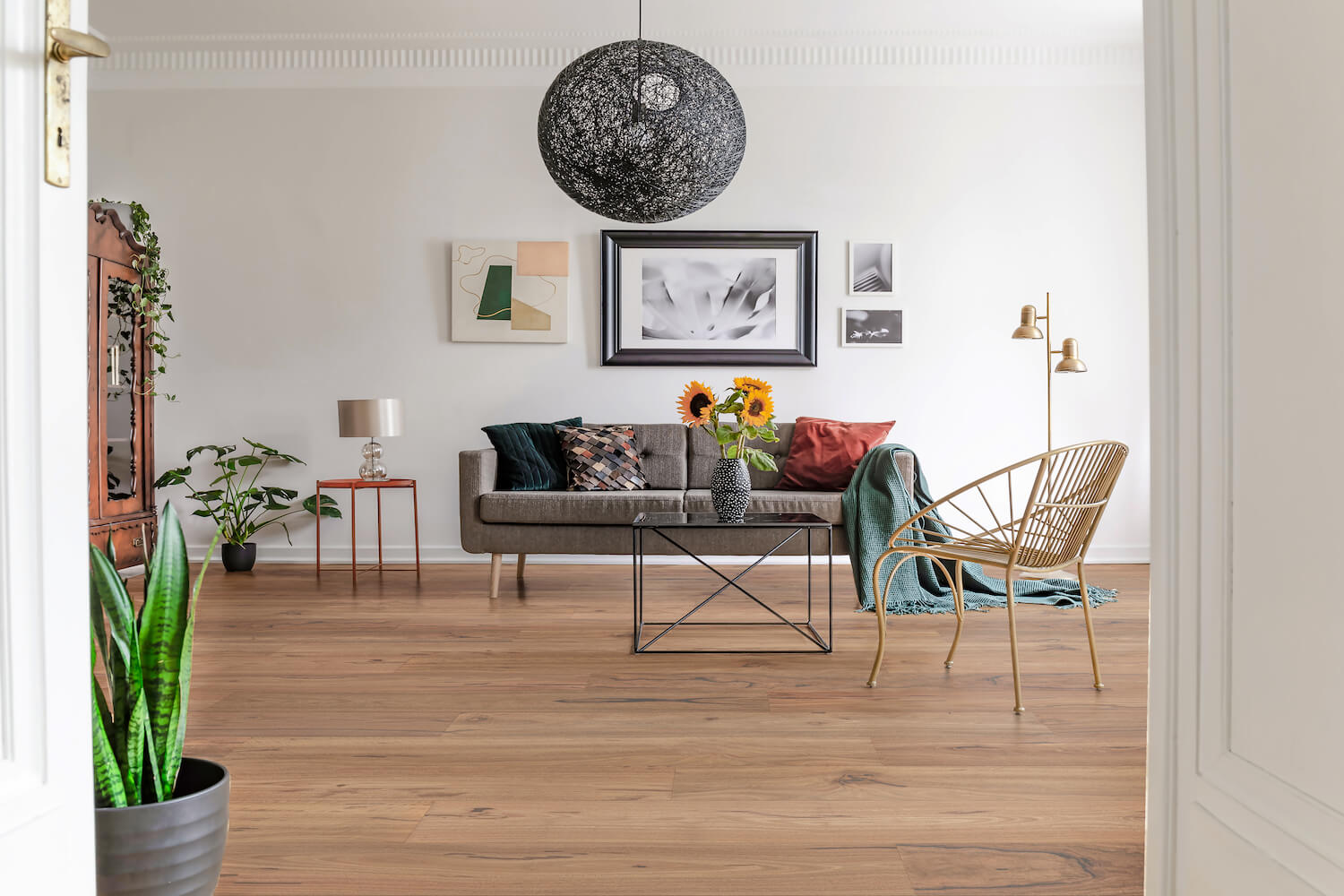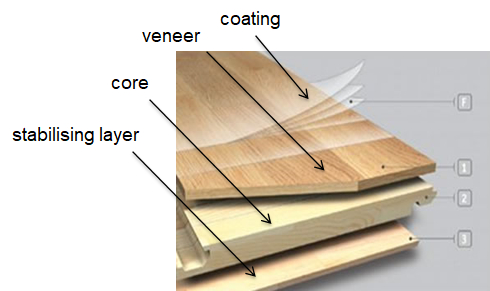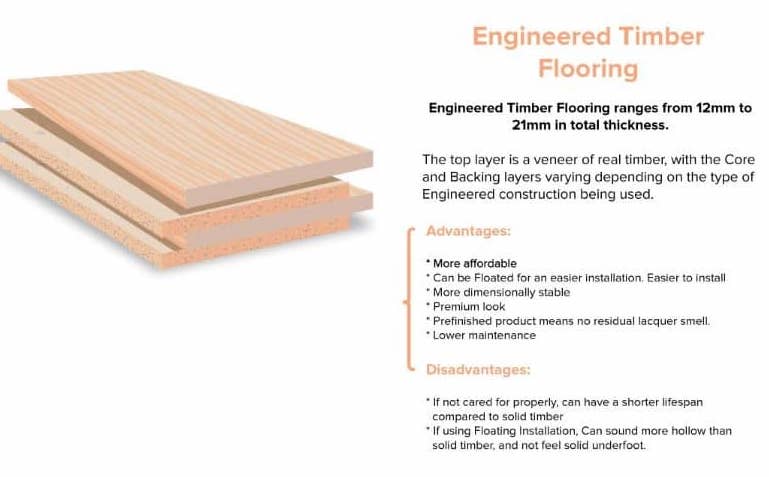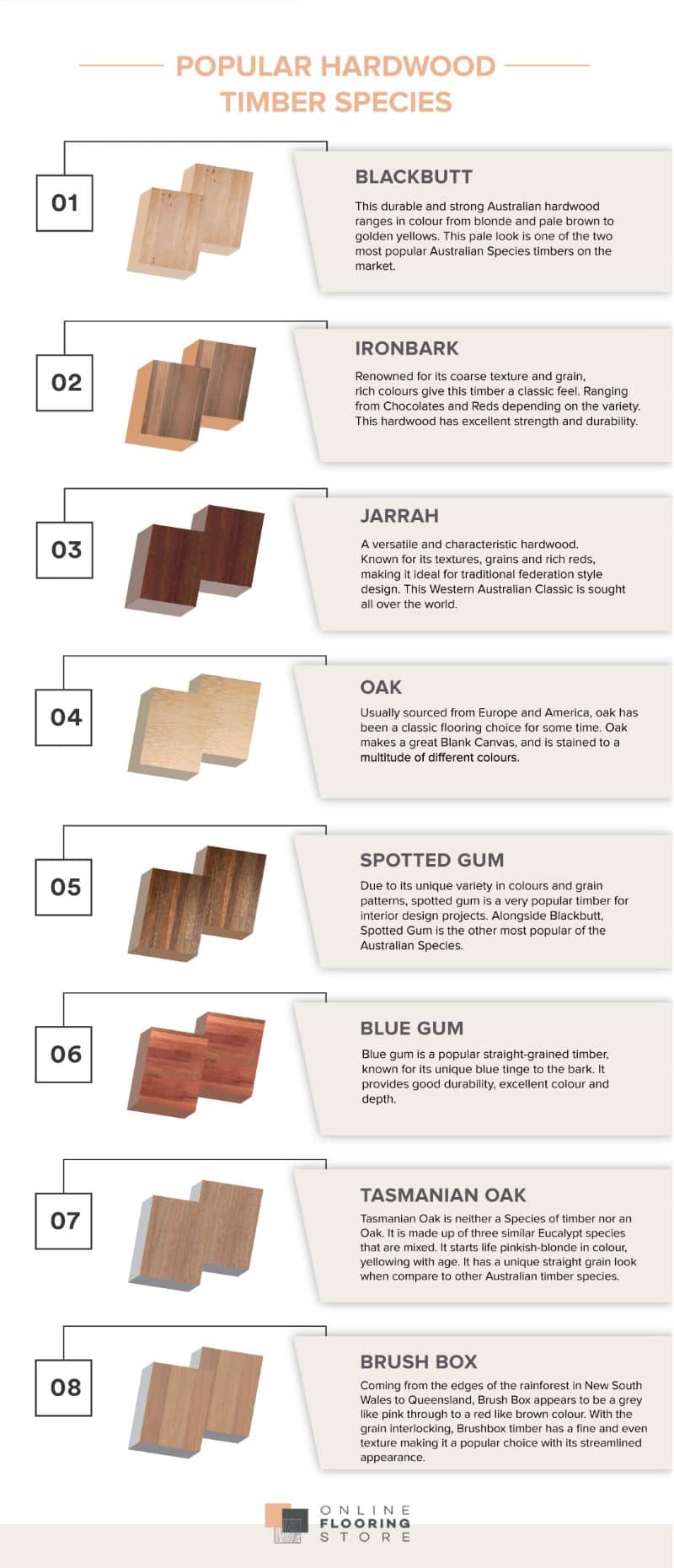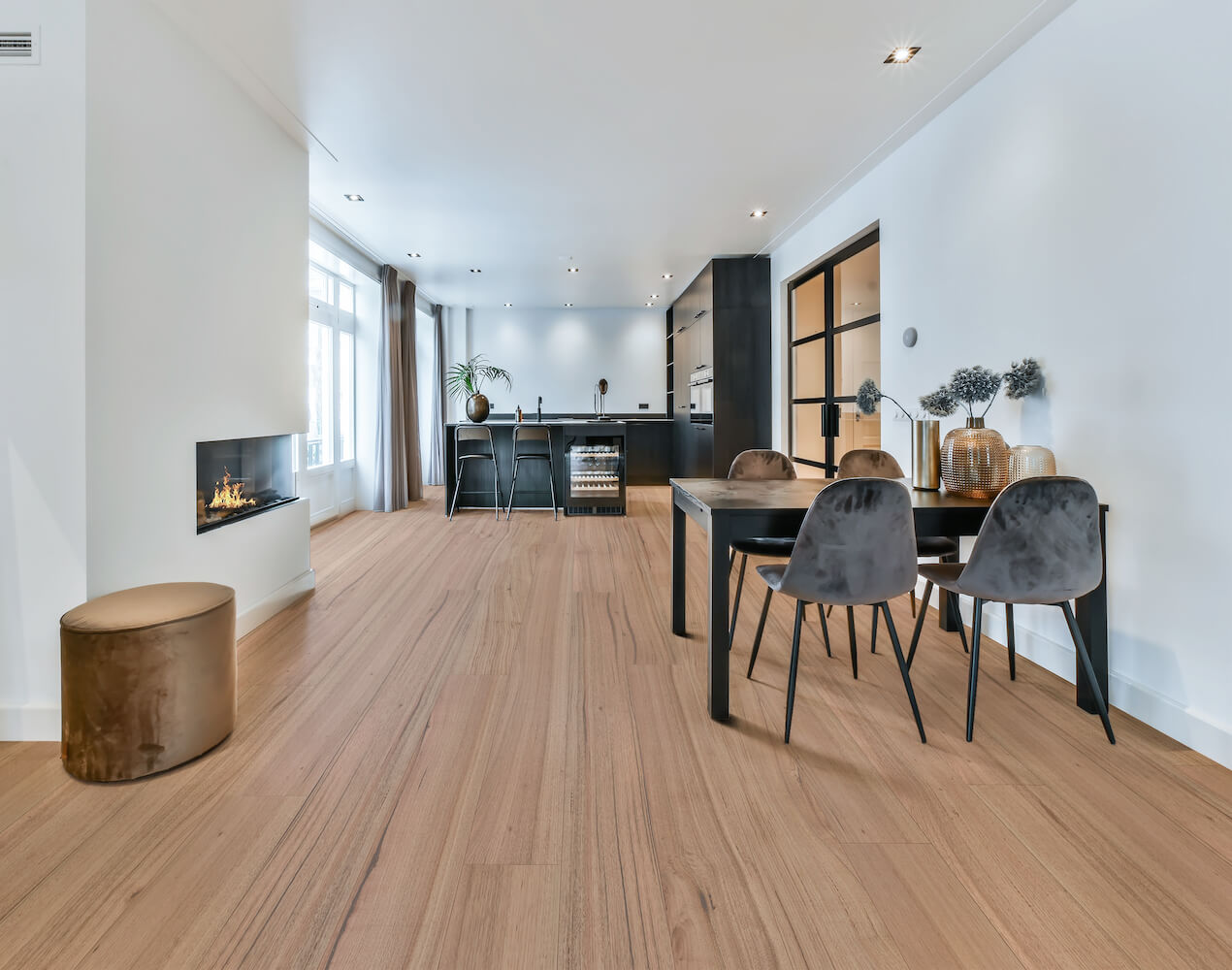Engineered timber flooring looks like solid wood, is faster to install, and is less susceptible to moisture damage. In so many cases, it is the ideal flooring option. This post covers the pros and cons of engineered timber flooring, including information about this unique, low-fuss, high-tech flooring type and whether it fits your style and needs.
What Is Engineered Timber Flooring?
An engineered wood floorboard typically consists of a thin, real hardwood veneer on the surface, laminated to two or more other materials.
Layers can typically include:
- Coatings
- Real hardwood layer
- Core made from Plantation grown timbers, ply, HDF or even SPC
- Backing layer
The veneer is 100% natural wood from various species, ranging from .6mm to 6mm thick. It is the layer after which the timber takes its name.For example, if the timber is called ‘Spotted Gum,’ the veneer will be made from Spotted Gum.
Because of the different sub-layers used in the core and backing of the boards, natural hardwood’s ability to expand and contract is greatly inhibited, usually three to four times less than that of solid timber flooring. As discussed in this post, the acclimatisation of engineered flooring is an issue that should be considered and can be done in a few simple steps.

Expert Insights From Dean Billett
28+ Years of flooring industry experience
A little-known advantage of engineered timber flooring's thin top veneer is that it reduces the stresses caused by climatic changes compared to those in solid timber floors.
A supplier will determine this based on access to core materials and cost considerations.
Download our Ultimate Guide to
Understanding Timber Flooring
Look at Engineered Wood’s Makeup
If you were to look at some of our engineered timber options, such as Eclipse Divine Engineered timber flooring or Australian Natives by Hurford’s, you would almost certainly assume this rich-looking flooring is real hardwood. Looks, however, can be deceiving. Yes, the top is real wood, but what is underneath can vary considerably.
Since its invention in the 1960s, engineered wood flooring has significantly improved appearance, quality, durability, and performance. The design options are full of potential, with a wide range of surface effects, patterns, and colours.
Below, we discuss both the product’s pros and cons of engineered flooring:
Pros of Engineered Timber Flooring
Engineered timber flooring offers many benefits, making it an excellent option. As detailed below, it also has certain aspects that make it more appealing than solid hardwood.
-
Increased Installation Options
Engineered timber’s layered construction provides stability for installation in volatile environments. It can often be installed in areas that would not be suitable for solid hardwood, such as under-floor heating systems (in most cases), basements, or concrete floors.
This makes engineered timber a versatile option for areas where you want a beautiful end result. If durability, humidity, or temperature changes are top concerns, engineered timber is worth considering if you have to have real timber.
Budget-minded homeowners can also install engineered timber as a DIY product where it is suitable. This can save homeowners a significant amount of money while still providing a lovely final result.
So, what installation options do you get with engineered hardwood flooring?
Floating floor
This typically works best with a locking system (but you can use tongue and groove), which holds the boards together, and the weight of the floor holds the floor in place. This is typically the cheapest and most DIY-friendly option because the flooring is not bonded to the subfloor, meaning you can easily remove or replace it. However, there are several limitations around refinishing, sound, and feeling underfoot.
Direct Sticking
We only recommend this path for professional installers. It involves using adhesive to stick the flooring to the subfloor. It is a permanent option with no room for errors and the added stress of drying time with the bonding agents. Once the flooring is directly stuck, you need a jackhammer to remove it, but the benefits often outweigh the costs. The flooring looks, feels, and sounds identical to solid hardwood underfoot. Refinishing the floor is viable, whether you simply want to recoat it or sand it back raw and change its colour.
In this article, we dive deep into the pros and cons of direct sticking or floating engineered floors.
-
More Affordable
It makes sense that engineered timber tends to be less expensive than solid hardwood. After all, only the top layer is made from the slow-growing hardwood, and the rest is composed of faster-growing or synthetic options. Engineered timber is also less expensive to lay when using professional contractors, or if you decide to tackle the floor as a DIY project, it becomes less expensive again! That said, even direct slick will be much cheaper than laying solid timber flooring because you do not have the sand to finish it.
If your space has a concrete subfloor, this usually makes the flooring less expensive and less complicated to install. Australian standard floor preparation tolerances still apply.
-
Versatile and Aesthetically Appealing
Engineered timber creates a warm, inviting atmosphere when used in a space. With various colours and options, any design—chic, modern, rustic, industrial, urban—can be complemented by engineered timber’s timeless appearance and cohesive style. Many timber species are available in engineered timber flooring, from Aussie classics such as spotted gum and blackbutt to European and American oak, hickory, and maple. The timeless look of hardwood flooring effortlessly transfers into engineered flooring because it is real hardwood flooring. This blog covers 6 Australian timber species commonly used in flooring.
Like solid hardwood flooring, engineered timber flooring is installed correctly and will add value to your home. It is a great way to reinvest in your property. Engineered timber boasts a natural appearance, unmatched beauty, and warmth that meshes with any setting. With the rising popularity of engineered timber, the range of colours and styles continues to advance thanks to rapid advancements in technology and manufacturing processes.
-
Impressive Stability in the Environment
Engineered flooring is typically more stable due to its layered construction. Because the layers run perpendicular to each other, expansion and contraction are usually less of a problem during hotter and colder months. Although this is true, many homeowners and floor layers underestimate expansion and contraction with timber flooring. Acclimatising your products to your environment and having the correct expansion breaks and gaps in place is the only way to ensure your products look good through the seasons. The environment in which engineered flooring is manufactured is often drastically different to the environment of the average Australian home. Therefore, allowing the product to sit and air in the house for a few weeks before installation is better.
Expert Insights From Clem Sturgess
20+ years' experience in hard flooring
This increased stability of engineered timber flooring also allows for wider planks than regular solid hardwood while being cost-effective.
-
Option for Refinishing
If you have floated your engineered timber floor, chances are you won’t be able to sand and recoat the floor, as well as a direct stuck floor if you can re-send it. A flooring salesperson often misses this detail when they tell you the floor can be sanded and recoated. The floor typically bounces when you sand off the top coat with a poly-vac, often leaving semi-circular, radial marks.
In the case of direct stuck floors, refinishing is a real option. Light cutbacks and total removal of the original coating are possible, giving you the option of changing the colour of your floor and/or choosing a different coating, such as oil or hard wax oil.
-
Better for the Planet & Your Health
Timber products are known for being among the most sustainable flooring options. However, engineered timber takes sustainability a step further since planks make better use of slow-growing hardwood species. The thinner top layer requires less slow-growing timber than a solid timber floor. This translates to more boards from one tree, making better use of a limited resource. In general, Engineered Timber Flooring provides many times the amount of square metres of flooring over solid timber flooring per cubic metre of the valuable hardwood used.
Engineered timber boasts a wealth of advantages, and there is a growing focus on health. Studies suggest that timber and wood products may positively impact mental health thanks to their stress-reducing effects. This is partly due to the nature-like atmosphere timber products help create.
If someone in your family has allergies, timber flooring should be at the top of your list of flooring options. Timber flooring creates a cleaner indoor environment since it does not harbour pet dander, mould, dust, pollen, or other dangerous, irritating allergens.
-
Underfloor Heating
Engineered hardwood is far more compatible with underfloor heating than solid timber flooring. The multiple layers reduce the risk of warping due to heat rise and decline, causing the moisture level of the floor to rise and fall. You can achieve the warmth of underfloor heating and timber’s aesthetic feel. That being said, the product would not conduct heat as well as solid hardwood. You should always consult the supplier’s guidelines when thinking of Underfloor Heating.
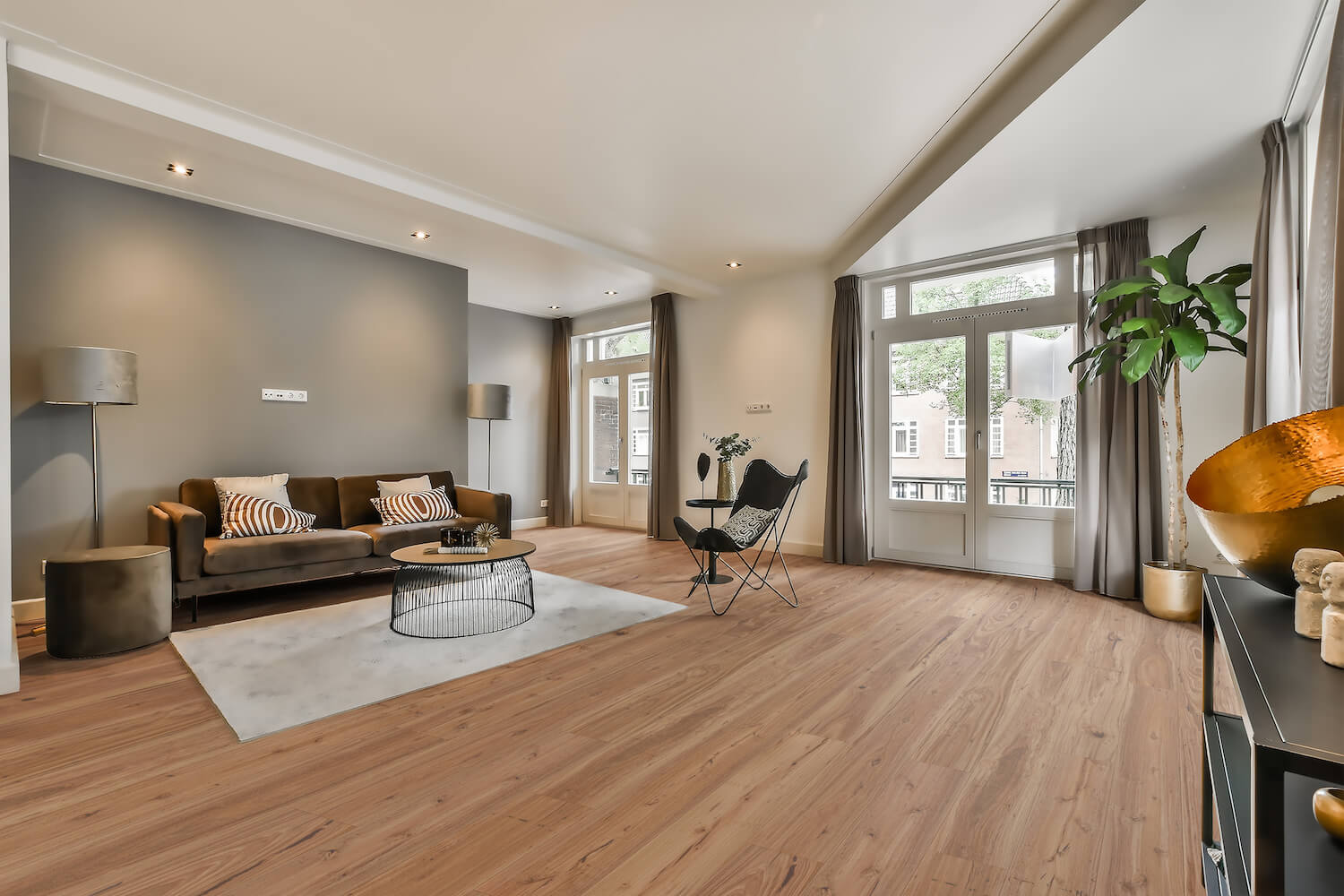
Empire OZ Engineered Timber Blackbutt Rustic
Cons of Engineered Timber Flooring
While engineered timber flooring offers numerous benefits, knowing its potential drawbacks is essential to making an informed decision.
Below are some cons associated with engineered timber flooring:
-
Limited Refinishing Potential
Engineered timber flooring can only be refinished a limited number of times. This limitation is due to the thin top layer of hardwood and varying wear layers. Unlike solid hardwood, which you can sand and refinish multiple times, the wear layer on engineered timber is usually only 3-7mm thick. If the floor suffers significant damage, sanding it down without exposing the core layers beneath the hardwood veneer may not be possible. We recommend light sand and cutback after a few years, strengthening the wear layer, and the top veneer is less likely to wear down.
-
Susceptibility to Water Damage
Although engineered timber is more moisture-resistant than solid hardwood, it is not entirely immune to water damage. Prolonged exposure to moisture can cause the layers to delaminate or warp. This makes it less suitable for areas prone to high humidity or frequent spills, such as bathrooms or kitchens. In cases of significant water exposure, repairs can be costly and may involve replacing entire sections of the flooring.
-
Potential Off-Gassing of VOCs
Some low-quality engineered timber flooring products are manufactured using adhesives that contain volatile organic compounds (VOCs). These VOCs can off-gas over time, contributing to indoor air pollution and potentially causing health issues. While many manufacturers now offer low-VOC or VOC-free options, checking the product specifications and certifications is crucial to ensure a healthier indoor environment.
-
Durability Issues
The durability of engineered timber flooring largely depends on the quality of the product. Low-quality engineered timber may have a thinner wear layer and less stable core layers, making it more susceptible to damage from heavy furniture, high foot traffic, and everyday wear and tear. Over time, this can lead to visible scratches, dents, and other signs of wear that may require premature replacement.
This blog will assist you in repairing and replacing damaged flooring.
-
Cost Considerations
While engineered timber flooring is generally less expensive than solid hardwood, it is still more costly than other options like laminate, vinyl, or carpet tiles. Additionally, high-end engineered timber can be as expensive as solid hardwood. For budget-conscious homeowners, the initial cost of purchasing and installing engineered timber may be a significant factor to consider.
-
Inconsistent Quality
-
Limited Lifespan
Despite its many advantages, engineered timber flooring does not typically last as long as solid hardwood. While well-maintained solid hardwood floors can last for decades, even centuries, engineered timber floors usually have a lifespan of 20-30 years, depending on the quality of the product and the level of care. This shorter lifespan means you may need to replace engineered timber flooring sooner than solid hardwood, potentially increasing long-term costs.
Empire OZ Engineered Timber Victorian Ash
Applications Around The Home & Maintenance
Engineered timber flooring is highly versatile and adds significantly to your home, office, or desired space. Installing engineered timber flooring can make smaller spaces feel larger, making it ideal for cramped rooms. If you are a dog or cat owner, hardwoods, including engineered ones, aren’t the most pet-friendly floors because they are more susceptible to scratching and water damage (especially urine) than other flooring options, such as vinyl or Hybrid Flooring.
Engineered timber floors are generally low maintenance and easy to care for.
Treat them similarly to solid timber flooring in many ways:
- Avoid using generic detergents as they may cause permanent damage
- Wipe up any spills immediately so the liquid does not linger on the floor’s surface
- Regular sweeping and vacuuming are essential to keep floors free of dirt and dust


